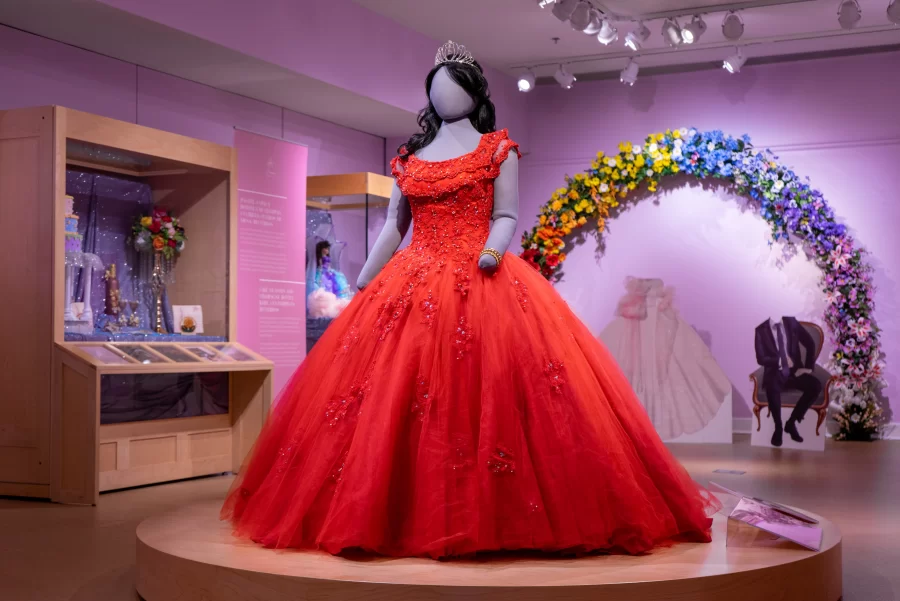Spurlock quinceañera exhibit brings valuable representation to UI
A quinceañera dress is showcased at Spurlock Museum’s exhibit, “Quinceañeras: Celebration, Joy, and Ethnic Pride,” that opened on Sept. 24 and will be on display until Dec. 4.
Nov 14, 2022
Right now, when someone walks into the Spurlock Museum on campus at the University, they are greeted with vibrant colors and decorations. Videos of baile sorpresas and photos of celebrations are played and hung on the walls.
For many, the “Quinceañeras: Celebration, Joy, and Ethnic Pride” exhibit displayed at Spurlock has brought truthful and accurate representations of a sacred celebration of womanhood for many communities.
The free exhibit, which opened on Sept. 24 and runs until Dec. 4, was launched during Hispanic Heritage Month as another effort to diversify and educate the Champaign-Urbana community.
Emmett Zumerchik, junior in ACES, has worked at Spurlock Museum alongside the exhibit. She highlighted the valuable information she observed while working.
“I feel like it’s important because one of the videos that they show talks about how women in the Latino culture take this as an important symbol of life, and it’s a coming-of-age tradition,” Zumerchik said. “I think it helps students become culturally aware and diversify their minds.”
Get The Daily Illini in your inbox!
Zumerchik said she sees it as an interactive exhibit.
“I’d like to say that it’s very interactive,” Zumerchik said. “I always see people coming in, taking photos and laughing and smiling, so you should come check it out.”
The exhibit was composed by a team of doctoral students under the direction of Dr. Angharad N. Valdivia, research professor at the University.
Ariana A. Cano, graduate student in the Institute of Communication Research, is a part of the team. Cano has six years of experience as a quinceañera choreographer, which gave her inside information about quinceañeras, while making the exhibit with her team.
“My own expertise and cultural background of having a quinceañera, going to quinceañeras (and) being in quinceañeras helped me,” Cano said. “To prepare, we kind of decided, in the span of a year, to organize the museum following what the quinceañera process looks like.”
The exhibit starts from the planning processes and goes all the way to the aftermath of the party and how the tradition lives on in through mainstream media representations.
A more in-depth view was meant to be achieved through the creation of the exhibit for all people to become more educated about the traditions of quinceañeras.
“What do quinceañeras mean for a girl who is 15 and coming of age?” Cano asked. “Suddenly she’s like, ‘What? I’m a woman now? What does that mean?’ I think it gives us a more in-depth view of Latino culture, but it tells us more about cultures themselves — it tells us more about identity, (and) it tells us more about gender through the examples of quinceañera.”
It was important to the creators to gain accurate information to provide the public with.
Mary Anaya, freshman in LAS, visited the exhibit as part of an assignment for class. She had her own quinceañera and reflected on her experiences while at the exhibit.
“I thought that was pretty accurate, especially since that’s what I had for my quinceañera,” Anaya said. “The outfit they had for the surprise dance reminded me of mine and it was kind of similar.”
As a member of the Latinx community, Anaya said she understood the importance of not only familiarizing the exhibit with people who were not knowledgeable about that aspect of Latinx culture, but also promoting self-reflection.
“I think it’s important because, for our culture — Latinx and other cultures as well — it’s good to remind ourselves where we come from and our traditions,” Anaya said. “It’s important to celebrate womanhood and how far we’ve come in life. For other cultures, it’s important to educate and take out the ignorance from educating on how quinceañeras are valued in Latinx culture.”
Cano stressed the importance of providing financial support to the on-campus Latinx community so students can focus on bringing cultural aspects and organizing without the worries of financial insecurity.
“That allows students, faculty and people to not have the stress of worrying about work and other things that come with financial things,” Cano said. “Then, they can explore ways where their culture is applied to the institution or academics. Also, aside from food, you can bring in literature — you can bring in guest speakers.”
Cano urged students to come to the University as authentic versions of themselves. She explained that if students come as they are, from whatever background they descend from, the University can gain valuable perspectives that build better resources.
“Students themselves should just come authentically, so they should just come with whatever they already come with,” Cano said. “Whether it’s my culture in Pilson or my culture wherever — this is what I have to offer in this community. Whether I am studying hard sciences or humanities, this is what I bring from my culture, and it applies to these areas. Just coming off as true to who you are.”






